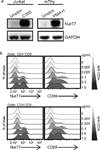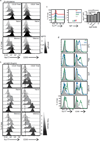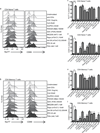Endogenous Nur77 Is a Specific Indicator of Antigen Receptor Signaling in Human T and B Cells
- PMID: 27940659
- PMCID: PMC5224971
- DOI: 10.4049/jimmunol.1601301
Endogenous Nur77 Is a Specific Indicator of Antigen Receptor Signaling in Human T and B Cells
Abstract
Distinguishing true Ag-stimulated lymphocytes from bystanders activated by the inflammatory milieu has been difficult. Nur77 is an immediate early gene whose expression is rapidly upregulated by TCR signaling in murine T cells and human thymocytes. Nur77-GFP transgenes serve as specific TCR and BCR signaling reporters in murine transgenic models. In this study, we demonstrate that endogenous Nur77 protein expression can serve as a reporter of TCR and BCR specific signaling in human PBMCs. Nur77 protein amounts were assessed by immunofluorescence and flow cytometry in T and B cells isolated from human PBMCs obtained from healthy donors that had been stimulated by their respective Ag receptors. We demonstrate that endogenous Nur77 is a more specific reporter of Ag-specific signaling events than the commonly used CD69 activation marker in both human T and B cells. This is reflective of the disparity in signaling pathways that regulate the expression of Nur77 and CD69. Assessing endogenous Nur77 protein expression has great potential to identify Ag-activated lymphocytes in human disease.
Copyright © 2017 by The American Association of Immunologists, Inc.
Figures







References
Publication types
MeSH terms
Substances
Grants and funding
LinkOut - more resources
Full Text Sources
Other Literature Sources

